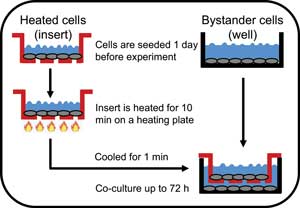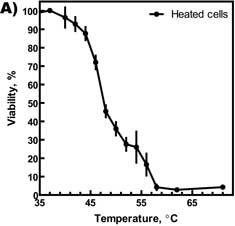
Active thermal bystander effect: Killing at a distance
Bystander effect is a well known social psychological phenomenon, in which people witness an incident without getting involved, and are affected in some way. For example, they may suffer “post-traumatic stress”. On a biological cellular level, the definition of a bystander effect is similar but more precise. Bystander cells which are not directly harmed can suffer severe damage or even be killed. This remote killing was discovered approximately 10 years ago in radiation research where distant non-irradiated cells exhibited a stress response similar to the irradiated cells. Clearly, there are “signals” passed through the medium, from the irradiated to the non-irradiated cells. We recently discovered that even minor heating can trigger a similar response. We named this heat induced phenomenon - Active Thermal Bystander Effect (ATBE) (Purschke, et al. 2009). Briefly, heat-exposed cells cause DNA damage and programmed cell death (apoptosis) in non-heated surrounding cells without any heat exposure or direct cell-to-cell contact. This results in a loss of viability of up to 10% in these bystander cells. The ATBE is triggered in temperature ranges of 46-50ºC where at least 50% of the heated cells are still viable to generate the bystander signal. This implies an active process, since the ATBE seems to require that living targeted cells must generate the bystander signal. The ATBE is a general phenomenon that appears in different cell lines but is more pronounced in fast dividing cancer cell lines. Our current focus is to identify the ATBE pathway and the mediators involved. Our initial data suggests that radical oxygen species (ROS) are involved in the ATBE pathway. The ROS levels are increased in the heat-exposed as well as in the bystander cells. In addition, the extracellular medium also shows an increased ROS level 1 h after heat-exposure.
ATBE has the potential for helping reduce burn injury, and for clinical applications. Developing that potential depends on our understanding of the mechanisms. In theory, ATBE could be used to sensitize a tumor, or to make the surrounding normal tissue more resistant by either applying or by suppressing the mediator. It also might be of clinical relevance for acute burn trauma, hyperthermic treatments, and distant tissue damage after large area burns and heat stress.
 |
| Experimental setting: Cells were seeded and cultured separately in inserts and wells. After heat exposure of the inserts, followed by a cooling off period, cells in inserts and wells were co-cultured for up to 72 h. |
 |
 |
| Cell viability. A) Heated cells show a temperature depending decrease in viability with a shoulder at the beginning. B) Bystander cells also show a loss in viability which is temperature depending up to 50ºC. Above 50ºC the viability of the bystander cells returns to control levels. All data represent 5 to 20 independent experiments for each temperature. | |













